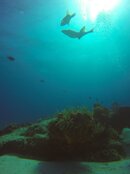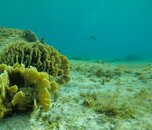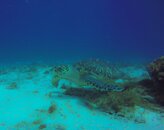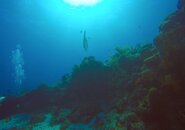Heh...more good luck than good management. We were at our safety stop when we saw an eagle ray coming our way. I dropped straight down, unfolding my camera rig and restarting everything I had shut off, as I was right on top of it. Unfortunately I had been in macro mode when I shut it down so had to fiddle a bit and missed a couple of really terrific shots. The permits were velcroed to the eagle ray so that even when it was right down in the sand, they were still under it (sideways!).Hi @MMM
Both your Eagle Ray shots are gorgeous. How did you get the 2 Permits to pose so nicely in the 2nd shot?
Good diving, Craig
You are using an out of date browser. It may not display this or other websites correctly.
You should upgrade or use an alternative browser.
You should upgrade or use an alternative browser.
Ready....aim....click.....oh crap
- Thread starter wildbill9
- Start date
Please register or login
Welcome to ScubaBoard, the world's largest scuba diving community. Registration is not required to read the forums, but we encourage you to join. Joining has its benefits and enables you to participate in the discussions.
Benefits of registering include
- Ability to post and comment on topics and discussions.
- A Free photo gallery to share your dive photos with the world.
- You can make this box go away
Dead rock being the operative words here. Not all divers (even some experienced ones) seem to understand what those are. The guy I dive with has had to have a word or two with supposedly experienced people who claimed they knew the difference. They didn't. Jamming them into coral, sponges, etc. etc. Don't assume you will be allowed to use these automatically in the Marine Park or that the DM won't tell you to put them away if you use them inappropriately. I think too often they are a substitute for good buoyancy control.Get one of these pointers, strap it on your left wrist, hold the yellow handle with your left hand with the red tip anchored on a dead rock to steady yourself
Dan
Contributor
Dead rock being the operative words here. Not all divers (even some experienced ones) seem to understand what those are. The guy I dive with has had to have a word or two with supposedly experienced people who claimed they knew the difference. They didn't. Jamming them into coral, sponges, etc. etc. Don't assume you will be allowed to use these automatically in the Marine Park or that the DM won't tell you to put them away if you use them inappropriately. I think too often they are a substitute for good buoyancy control.
I learnt this trick from the DM himself. He also used it to point the little critters, which often I didn't see them until they moved.
I have used it for 12 years in many places, including marine parks, such as Komodo, Raja Ampat, Cabo Pulmo, Galápagos, Bunaken, Lembeh, Wakatobi, GBR, etc. and haven't, yet, been disallowed to use it (knock on wood).
Only idiots would use it to jam it into the coral, sponges. I haven't seen those guys around, thank goodness.
It's much better than sticking your finger onto the dead rock & having your hand got brushed over by waving hydroids as the current sweeping over your hand, as gloves are not allowed in some of these marine parks.
The pointer helps your hand elevated high enough above the hydroids from touching your bare hand. Sometimes the only accessible view is between the hydroids like this blue-ringed octopus and yellow-mask angelfish, below.
Another trick that I learnt from underwater photographer is to shoot at low position or at least level with the object, with ocean blue background, if possible (often is not possible, so you take what you get). So, when you lower your head down, you need to be aware of your surrounding. You don't want your face got whipped by that dang hydroids.
Last edited:
cicopo
Contributor
With good buoyancy you have TWO hands available to hold the camera steady which is the preferred method, especially with strobes or aux lights used to aid the AF. One hand holding a pick leaving the other to operate & control the camera isn't great in the current we work in along Cozumel's Reefs.
Yes, and with good buoyancy control, you don't need to put a finger on the reef and/or risk hydroid stings.With good buoyancy you have TWO hands available to hold the camera steady which is the preferred method, especially with strobes or aux lights used to aid the AF. One hand holding a pick leaving the other to operate & control the camera isn't great in the current we work in along Cozumel's Reefs.
Dan
Contributor
Yes, and with good buoyancy control, you don't need to put a finger on the reef and/or risk hydroid stings.
I do that in calm water. The stick is used when there is current to avoid finning & camera shake.
- Messages
- 4,651
- Reaction score
- 6,389
- # of dives
- 200 - 499
Like so many here on SB like to say, "This is a technical solution to a skills problem."
Illinois Diver
New
I am new to this forum and just beginning my return to diving, so I cannot provide much more than beginner's advice. I can say, though, that what I did learn on my first trip to Cozumel last April is that the basic principles of photography apply both above and below the waterline. What I mean by that is take advantage of the equipment that you have, use it to the best of its ability, but don't try to do too much with it.
When I was blessed enough to be in Cozumel, I was using a gopro for both still pictures and video. It was not reasonable for me to go after the detailed macro shots that I can take above water with my real camera. In response, I had to focus on composing pictures as I drifted.
When I was blessed enough to be in Cozumel, I was using a gopro for both still pictures and video. It was not reasonable for me to go after the detailed macro shots that I can take above water with my real camera. In response, I had to focus on composing pictures as I drifted.
Illinois Diver
New
Sorry: not sure why the photos ended up splitting the text but when I choose the edit feature they are after the text just as intended. Seems things are confusing. I have tried to attach 4 files but the same 2 appeared in my message twice so I re edited to remove 1 pair of them, but they still seem to be showing. These are the RAW samples
View attachment 397448 View attachment 397448 View attachment 397449
Nice shots. Can you elaborate a little more on what Photoshop adjustments you made in the thirty seconds of post processing. Really improved the image. Another question - would these same things apply to video?
Similar threads
- Replies
- 20
- Views
- 868
- Replies
- 39
- Views
- 5,641








